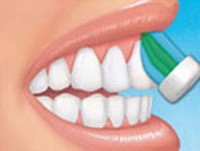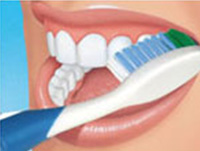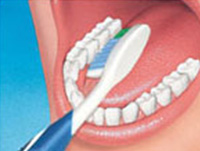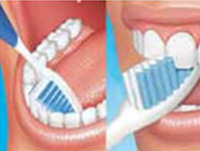
It is not a widely known fact that brushing your teeth correctly using the correct texture of toothbrush is more important than the brand of toothpaste or toothbrush you use. Though many brushing techniques are available, this section will display the one that is relatively easy an defective for most individuals.
How to Use Floss
Dental floss is a thin, soft thread made of nylon or plastic which removes food and plaque from between your teeth.
4 MINUTES A DAY TO HELP BRUSH PLAQUE AWAY
Brushing every day is a fundamental component to effective oral hygiene helping keep teeth and gums from bacterial biofilm (plaque). Plaque (bacteria) is constantly forming on your teeth. Therefore, it is recommended that you brush 2 minutes in the morning and 2 minutes in the evening, no less, in order to efficiently remove this "sticky film". While growing up, children are often told to brush after eating their favourite sugary or starchy food or beverage. The reason has to do with the interaction between these foods and the bacteria in the mouth. In the presence of sugars or starches, the bacteria produce an acid that attacks the tooth enamel. The stickiness of the plaque keeps the acid in contact with your teeth. Without the removal of the plaque, dental caries (cavities) will progressively appear.
Plaque needs to be removed through a daily oral care routine which includes brushing and flossing or the plaque will harden into tartar (or calculus). When it hardens, the tartar will need to be removed by your dental professional. Effective oral health starts with the gums. Today, gum disease is one of the most common dental problems. One of the issues with gum disease is that it often develops slowly and without pain. When plaque (tartar) is allowed to accumulate, infection will occur at the point where the gums attach to the teeth (called the "point of attachment").
Dental Home Care
One must brush and floss regularly after every meal and at a minimum twice a day. The key is not only to do it regularly but also to do it right. Here's how:

1. Place bristles along the gumline at a 45 degree angle. Bristles should contact both the tooth surface and the gumline.

2. Gently brush the outer tooth surfaces of 2-3 teeth using a vibrating back, forth & rolling motion. Move brush to the next group of 2-3 teeth and repeat.

3. Maintain a 45 degree angle with bristles contacting the tooth surface and gumline. Gently brush using back, forth & rolling motion along all of the inner tooth surfaces.

4. Tilt brush vertically behind the front teeth. Make several up & down strokes using the front half of the brush.

5. Place the brush against the biting surface of the teeth & use a gentle back & forth scrubbing motion. Brush the tongue from back to front to remove odor-producing bacteria.
Use a good toothbrush
Your toothbrush should have soft nylon bristles which are gentle on your gums. It is recommended that you should get a new one every 3 months, or as soon as the bristles start to splay out and lose their shape.
Use a reputed branded toothpaste
A fluoridated toothpaste not only helps remove plaque, but also helps strengthen tooth enamel. Choose your toothpaste carefully based on your specific needs.

Wet your toothbrush
Squeeze only a moderate amount (approximately a little over half the length of toothbrush head) of toothpaste onto your toothbrush.